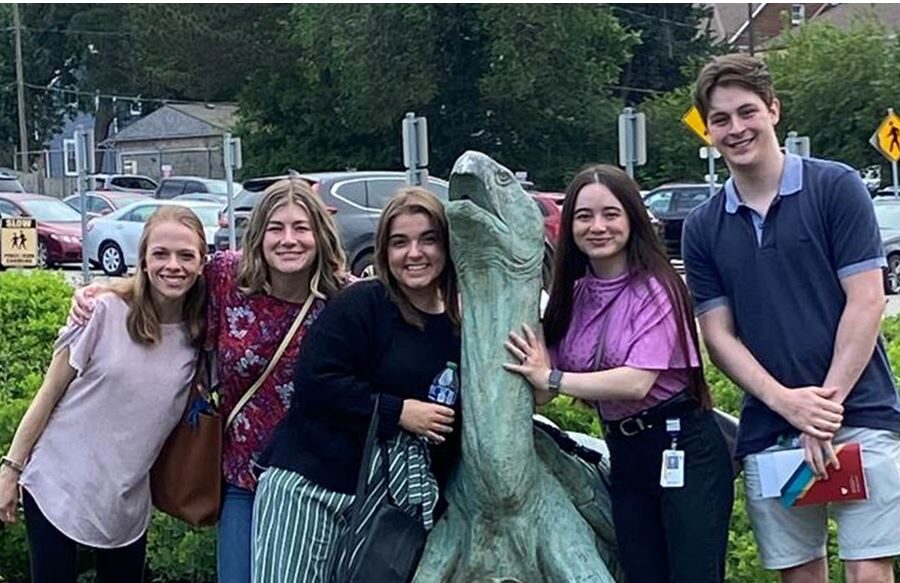During the MD-PhD retreat in August – an annual gathering of every UNMC student in the MD-PhD program – a group gathered in a clearing near the Lied Lodge in Nebraska City to try to catch a glimpse of the Perseid meteor shower.
Due to cloudy weather, viewing conditions weren’t the best, but Minnesota’s Sarah Uhm, beginning the program this year, did manage to see five shooting stars.
“It was amazing,” she said.
Coincidentally, there are five incoming MD-PhD students in this year’s class, including Uhm. But the symbolism seems to fall apart there, because the MD-PhD program – two years of medical school, three to four years to earn a PhD, and then two more years of medical school – isn’t really a “shooting star” kind of thing. In terms of an astronomical parallel, a Jovian year might be more apt.
“It’s tough to come in as a first year,” said Justin Mott, MD, PhD, director of the program. “It’s tough to transition to graduate school. It’s tough to transition back to medical school. It’s tough to apply for residency.”
But for Uhm and her fellow students, the lure of the MD-PhD program is an exciting one, and the possibilities as limitless as the autumn night skies.
“I’m interested in infectious diseases and immunology, as well as harm reduction,” Uhm said. “But I’ll be here for another eight years, so those interests will continue to grow. The program does a really great job of encouraging us to pursue our interests, but then also looking at different areas that we might not have initially thought to pursue.”
Alexis Shindhelm came to UNMC from North Carolina to pursue her interest in neurology and passion for the study of epilepsy.
“As a biomedical engineer, I love getting to see the neurotechnologies that are utilized for patients with refractory epilepsy. I’m very interested in trying to advance localization of the epileptogenic zone or the seizure onset zone where seizures originate.”
Shindhelm was especially excited by UNMC’s magnetoencephalography machine or MEG.
“That is a very high-caliber imaging modality that’s utilized for patients with refractory epilepsy that can help in localization of where the seizures are originating,” she said. “That’s what really drew me to UNMC.”
And Hannah Larsen, another Minnesota transplant and former research technician, is at UNMC to explore cancer research and care, lured in part by the Fred & Pamela Buffett Cancer Center.
“I’m not sure of the type of cancer I want to research yet, but I’m very interested in looking at cells and tissue and mechanisms of cancer development,” Larsen said. “There’s so much opportunity for that kind of research here, so I’m really excited.”
The August retreat is designed to foster that excitement. It’s one of several annual events that brings UNMC’s MD-PhD students together during the school year to provide MD-PhD students at all points in the program with information and support.
“The program has a fantastic spreadsheet of all student contact information, names of people in your year in the program, research interests and fun facts,” Uhm said. “That can help you connect with people who have shared interests. We’ve also had consistent mentoring sessions throughout the summer — during our anatomy boot camp, twice a week.”
Older students provide mentoring, while maybe getting recharged themselves by the excitement of the brand-new students. Classes are held to discuss subjects such as personal and academic growth, a mindset for success, networking opportunities and resiliency.
“One of the upperclassmen shared her experience with anatomy and told us to embrace failure and to use it as something from which we can grow,” Shindhelm said. “She said we all have a difficult time starting something as rigorous as an MD-PhD program. Having her share her personal experience was really encouraging.”
The new MD-PhD students started the school year ahead of the MD-only counterparts. For two months during the summer, the new students have been doing research rotations – Larsen already has had rotations at the Fred & Pamela Buffett Cancer Center.
“We also had our MD-PhD orientation in early June; that’s when we originally met each other,” she said. “We’ve also done some events with just our cohort, as well as other social events with all the MD-PhD students. That has been great.”
The new students also took a two-week, fast-track anatomy course in the beginning of June.
“Our community really started from that anatomy immersion at the beginning,” Shindhelm said. “That was great for bonding and getting to know who your classmates are going to be for the next seven or eight years.”
One of Dr. Mott’s favorite parts of this year’s retreat was an exercise where students set up paper bags, each with a student’s name on it. Other students wrote affirmations – one student called them “warm fuzzies” – and dropped them in the bags for their peers.
“I really liked that, because it allowed for a sort of connection without necessarily having to say something out loud,” he said. “People enjoy the chance to support each other, as well as the appreciation that they find in return.”
After all, the program’s students and alumni know the challenges, and the rewards, better than anyone.
“I really love research,” Uhm said. “I want it to be an integral and core part of my career moving forward.”
And that forward path? Not as speedy as a shooting star. But perhaps as bright and wondrous.
